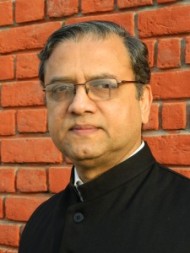 On Dec. 3rd, 2012 The Asian Age and Deccan Chronicle, India’s widely circulated honorary Catholic newspapers, published an article on St. Francis Xavier by Fr. Francis Gonsalves, former principal of the Vidyajyoti College of Theology, Delhi. Vidyajyoti is a Jesuit theological school and Jesuits as Christian ideologues are known best for their casuistry and sophistry in moral reasoning. Therefore it was not difficult for Fr. Francis to describe Francis Xavier in the article as having “blended a kaleidoscopic collage of virtues: intelligence, faithfulness, perseverance, joy, warmth, devotion, loyalty, courage, generosity, sportsmanship, and an incredible capacity to love and serve.” In fact Xavier was an arch criminal filled with an obsessive hatred of Hindus and their Brahmin priests—Brahmins had defeated him in debate at Thiruchendur and laughed at him when he claimed to be the representative of a “One True God”. He introduced forced conversions into India, often targeting children, and was a self-described gleeful breaker of temples and Hindu images. If he was alive and active today, he would be brought before the the International Criminal Court in The Hague for crimes against humanity. Yet the Catholic Church and Fr. Francis Gonsalves have the bare-faced audacity to hail this Spanish pirate in public as a saint. This tells us a lot about the values of Christianity and especially Indian Christianity which is known world-wide for its bigotry and religious intolerance. These values are best exemplified by the fact that the rotting corpse of the notorious temple-breaker, known as the Scourge of the Coromandal Coast, is kept in a shrine in the Basilica of Bom Jesus in Old Goa, a church that replaces the Saptakotishwar Shiva Temple of Old Goa destroyed by the Portuguese in the 1590s. Readers are encouraged to go to the links and comments below this article by Sita Ram Goel for more information concerning Francis Xavier and the establishment of the Inquisition in Goa which Xavier demanded that King John III of Portugal send, in a letter dated May 16, 1545. — Ishwar Sharan (Fr. Francis Gonsalves now teaches at the Papal Seminary in Pune.)
On Dec. 3rd, 2012 The Asian Age and Deccan Chronicle, India’s widely circulated honorary Catholic newspapers, published an article on St. Francis Xavier by Fr. Francis Gonsalves, former principal of the Vidyajyoti College of Theology, Delhi. Vidyajyoti is a Jesuit theological school and Jesuits as Christian ideologues are known best for their casuistry and sophistry in moral reasoning. Therefore it was not difficult for Fr. Francis to describe Francis Xavier in the article as having “blended a kaleidoscopic collage of virtues: intelligence, faithfulness, perseverance, joy, warmth, devotion, loyalty, courage, generosity, sportsmanship, and an incredible capacity to love and serve.” In fact Xavier was an arch criminal filled with an obsessive hatred of Hindus and their Brahmin priests—Brahmins had defeated him in debate at Thiruchendur and laughed at him when he claimed to be the representative of a “One True God”. He introduced forced conversions into India, often targeting children, and was a self-described gleeful breaker of temples and Hindu images. If he was alive and active today, he would be brought before the the International Criminal Court in The Hague for crimes against humanity. Yet the Catholic Church and Fr. Francis Gonsalves have the bare-faced audacity to hail this Spanish pirate in public as a saint. This tells us a lot about the values of Christianity and especially Indian Christianity which is known world-wide for its bigotry and religious intolerance. These values are best exemplified by the fact that the rotting corpse of the notorious temple-breaker, known as the Scourge of the Coromandal Coast, is kept in a shrine in the Basilica of Bom Jesus in Old Goa, a church that replaces the Saptakotishwar Shiva Temple of Old Goa destroyed by the Portuguese in the 1590s. Readers are encouraged to go to the links and comments below this article by Sita Ram Goel for more information concerning Francis Xavier and the establishment of the Inquisition in Goa which Xavier demanded that King John III of Portugal send, in a letter dated May 16, 1545. — Ishwar Sharan (Fr. Francis Gonsalves now teaches at the Papal Seminary in Pune.)
- Saint Xavier’s Exposition: Why it must stop – Sankrant Sanu
- Mangalore Christian group objects to the exposition of St Francis Xavier’s remains in Goa – India Facts
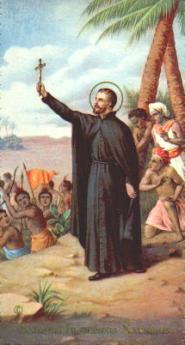 St. Francis Xavier: A pirate in priest’s clothing – Sita Ram Goel
St. Francis Xavier: A pirate in priest’s clothing – Sita Ram Goel
“Goa is sadly famous for its Inquisition, equally contrary to humanity and commerce. The Portuguese monks made us believe that the people worshipped the devil, and it is they who have served him.” – Voltaire
The European encounter between Hinduism and Christianity commenced with the coming of Christian missionaries to Malabar after Vasco da Gama found his way to Calicut in AD 1498. It took a serious turn in AD 1542 when Francis Xavier, a rapacious pirate dressed up as a priest, arrived on the scene. The proceedings have been preserved by the Christian participants. They make the most painful reading in the history of Christianity in India. Francis Xavier had come with the firm resolve of “uprooting paganism” from the soil of India and planting Christianity in its place. His sayings and doings have been documented in his numerous biographies and cited by every historian of the Portuguese episode in the history of India.
Francis Xavier was convinced that Hindus could not be credited with the intelligence to know what was good for them. They were completely under the spell of the Brahmanas who, in turn, were in league with evil spirits. The first priority in India, therefore, was to free the poor Hindus from the stranglehold of the Brahmanas and destroy the places where evil spirits were worshipped. A bounty for the Church was bound to follow in the form of mass conversions.[1]
 We shall let a Christian historian speak about what the Portuguese did in their Indian domain. “At least from 1540 onwards,” writes Dr. Teotonio R. de Souza of the Dept. of History, Universidade Lusofona, Lisbon, “and in the island of Goa before that year, all the Hindu idols had been annihilated or had disappeared, all the temples had been destroyed and their sites and building materials were in most cases utilised to erect new Christian churches and chapels. Various viceregal and Church council decrees banished the Hindu priests from the Portuguese territories; the public practice of Hindu rites including marriage rites, was banned; the state took upon itself the task of bringing up the Hindu orphan children; the Hindus were denied certain employments, while the Christians were preferred; it was ensured that the Hindus would not harass those who became Christians, and on the contrary, the Hindus were obliged to assemble periodically in churches to listen to preaching or to the refutation of their religion.”[2]
We shall let a Christian historian speak about what the Portuguese did in their Indian domain. “At least from 1540 onwards,” writes Dr. Teotonio R. de Souza of the Dept. of History, Universidade Lusofona, Lisbon, “and in the island of Goa before that year, all the Hindu idols had been annihilated or had disappeared, all the temples had been destroyed and their sites and building materials were in most cases utilised to erect new Christian churches and chapels. Various viceregal and Church council decrees banished the Hindu priests from the Portuguese territories; the public practice of Hindu rites including marriage rites, was banned; the state took upon itself the task of bringing up the Hindu orphan children; the Hindus were denied certain employments, while the Christians were preferred; it was ensured that the Hindus would not harass those who became Christians, and on the contrary, the Hindus were obliged to assemble periodically in churches to listen to preaching or to the refutation of their religion.”[2]
Coming to the performance of the missionaries, he continues: “A particularly grave abuse was practised in Goa in the form of ‘mass baptism’ and what went before it. The practice was begun by the Jesuits and was later initiated by the Franciscans also. The Jesuits staged an annual mass baptism on the Feast of the Conversion of St. Paul (25 January), and in order to secure as many neophytes as possible, a few days before the ceremony the Jesuits would go through the streets of the Hindu quarters in pairs, accompanied by their Negro slaves, whom they would urge to seize the Hindus. When the blacks caught up a fugitive, they would smear his lips with a piece of beef, making him an ‘untouchable’ among his people. Conversion to Christianity was then his only option.”[3]
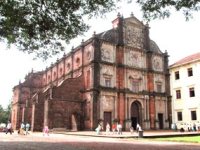 Finally, he comes to “Financing Church Growth” and concludes: “…the government transferred to the Church and religious orders the properties and other sources of revenue that had belonged to the Hindu temples that had been demolished or to the temple servants who had been converted or banished. Entire villages were taken over at times for being considered rebellious and handed over with all their revenues to the Jesuits. In the villages that had submitted themselves, at times en masse, to being converted, the religious orders promoted competition to build bigger and bigger churches and more chapels than their neighbouring villages. Such a competition, drawing funds and diverting labour, from other important welfare works of the village, was decisively bringing the village economy in Goa into bankruptcy.”[4]
Finally, he comes to “Financing Church Growth” and concludes: “…the government transferred to the Church and religious orders the properties and other sources of revenue that had belonged to the Hindu temples that had been demolished or to the temple servants who had been converted or banished. Entire villages were taken over at times for being considered rebellious and handed over with all their revenues to the Jesuits. In the villages that had submitted themselves, at times en masse, to being converted, the religious orders promoted competition to build bigger and bigger churches and more chapels than their neighbouring villages. Such a competition, drawing funds and diverting labour, from other important welfare works of the village, was decisively bringing the village economy in Goa into bankruptcy.”[4]
During the same period, Christianity was spreading its tentacles to Bengal. Its patrons were the same as in Goa; so also its means and methods. “The conversion of the Bengalis into Christianity,” writes Dr. Sisir Kumar Das, “not only coincided with the activities of the Portuguese pirates in Bengal but the pirates took an active interest in it.”[5] The Augustinians and Jesuits manned the mission with bases at Chittagong in East Bengal and Bandel and Hooghly in West Bengal. Mission stations were established at many places in the interior. “It was the boast of the Hooghly Portuguese,” records Dr. P. Thomas, “that they made more Christians in a year by forcible conversions, of course, than all the missionaries in the East in ten.”[6]
 The Portuguese captured the young prince of Bhushna, an estate in Dhaka District. He was converted by an Augustinian friar, Father D’Rozario and named Dom Antonio de Rozario. The prince, in turn, converted 20,000 Hindus in and around his estate. “The Jesuits came forward,” continues Dr. Das, “to help the neophytes to minister to the needs of the converts and this created bitterness between Augustinians and Jesuits…. In 1677, the Provincial at Goa deputed Father Anthony Magalheans, the Rector of the College at Agra, to visit and report on this problem. According to his report nearly 25,000, if not more, converts were there but they had hardly any knowledge of Christianity…. He also observed that many of them became Christians to get money. The Marsden Manuscripts now preserved in the British Museum containing letters of Jesuit Fathers, give evidence that Portuguese missionaries gave money to perspective converts to allure them.”[7]
The Portuguese captured the young prince of Bhushna, an estate in Dhaka District. He was converted by an Augustinian friar, Father D’Rozario and named Dom Antonio de Rozario. The prince, in turn, converted 20,000 Hindus in and around his estate. “The Jesuits came forward,” continues Dr. Das, “to help the neophytes to minister to the needs of the converts and this created bitterness between Augustinians and Jesuits…. In 1677, the Provincial at Goa deputed Father Anthony Magalheans, the Rector of the College at Agra, to visit and report on this problem. According to his report nearly 25,000, if not more, converts were there but they had hardly any knowledge of Christianity…. He also observed that many of them became Christians to get money. The Marsden Manuscripts now preserved in the British Museum containing letters of Jesuit Fathers, give evidence that Portuguese missionaries gave money to perspective converts to allure them.”[7]
The quality of the converts, though bewailed frequently by the missionaries, did not really perturb them. Frey Duarte Nunes, the prelate of Goa, had foreseen the situation as early as 1522. According to him, “even if the first generation of converts was attracted by rice or by any other way and could hardly be expected to become good Christians, yet their children would become so with intensive indoctrination, and each successive generation would be more firmly rooted.”[8]
It was a very difficult situation for Hinduism. But, by and large, Hindus chose to stay in the faith of their forefathers in spite of all trials and temptations. There was no mass movement towards the Church except the “mass baptisms” staged by the Jesuits. The mission was in a fix. The strategy of forced conversions recommended by Francis Xavier had failed. – History of Hindu-Christian Encounters: AD 304 to 1996, Voice of India, 1996
 Sayings of Francis Xavier – Ishwar Sharan
Sayings of Francis Xavier – Ishwar Sharan
In his letters to the Jesuits in Rome, Xavier wrote: “There are in these parts among the pagans a class of men called Brahmins. They are as perverse and wicked a set as can anywhere be found, and to whom applies the Psalm which says: ‘From an unholy race, and wicked and crafty men, deliver me, Lord.’ If it were not for the Brahmins, we should have all the heathens embracing our faith.”
“Following the baptisms, the new Christians return to their homes and come back with their wives and families to be in their turn also prepared for baptism. After all have been baptised, I order that everywhere the temples of the false gods be pulled down and idols broken. I know not how to describe in words the joy I feel before the spectacle of pulling down and destroying the idols by the very people who formerly worshipped them.” Xavier did this after the Hindu raja of Quilon had given him a large grant to build churches!
Xavier’s letter demanding the Inquisition be sent to Goa
Francis Xavier sent this letter to the King John III of Portugal on May 16th, 1545: “The second necessity for the Christians is that your Majesty establish the Holy Inquisition, because there are many who live according to the Jewish law, and according to the Mahomedan sect, without any fear of God or shame of the world. And since there are many spread all over the fortresses, there is the need of the Holy Inquisition and of many preachers. Your Majesty should provide such necessary things for your loyal and faithful subjects in India.” — Joseph Wicki, Documenta Indica, Vol. IV, Rome, 1956.
Historian Paul Roberts describes what went on in the Iquisition’s Goa court that had been housed in the Sultan’s old palace and had a huge plaster image of Christ overlooking the scene: “Children were flogged and slowly dismembered in front of their parents, whose eyelids had been sliced off to make sure they missed nothing. Extremities were amputated carefully, so that a person could remain conscious even when all that remained was a torso and head. Male genitals were removed and burned in front of wives, breasts hacked off and vaginas penetrated by swords while husbands were forced to watch…. And it went on for two hundred years.” — Paul Williams Roberts, The Empire of the Soul: Some Journeys in India, New York, 1997.
References
- Francis Xavier was the pioneer of anti-Brahmanism which was adopted in due course as a major plank in the missionary propaganda by all Christian denominations. Lord Minto, Governor General of India from 1807 to 1812, submitted a Note to his superiors in London when the British Parliament was debating whether missionaries should be permitted in East India Company’s domain under the Charter of 1813. He enclosed with his Note some “propaganda material used by the missionaries” and, referring to one missionary tract in particular, wrote: “The remainder of this tract seems to aim principally at a general massacre of the Brahmanas” (M. D. David (ed.), Western Colonialism in Asia and Christianity, Bombay, 1988, p. 85). Anti-Brahmanism has become the dominant theme in the speeches and writings of Indian secularists of all sorts.
- M.D. David (ed.), op.cit., p. 17.
- Ibid., p. 19.
- Ibid., pp. 24-35. For a detailed account of Christian doings in Goa, see A.K. Priolkar, The Goa Inquisition, Bombay, 1961, Voice of India reprint, New Delhi, 1991 and 1996.
- Sisir Kumar Das, The Shadow of the Cross, New Delhi, 1974, p. 4.
- P. Thomas, Christians and Christianity in India and Pakistan, London, 1954, p. 114.
- Sisir Kumar Das, op. cit., p. 5.
- M. D. David (ed.), op. cit., p. 8.
See also
Filed under: india | Tagged: basilica of bom jesus, christian terrorism, forced conversion, goa, india, inquisition, inquisition of goa, jesuit order, psychological warfare, roman catholic church, saptakoteshwar temple, st. francis xavier |


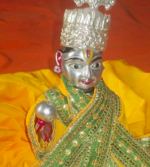






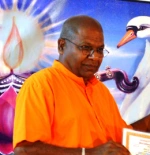

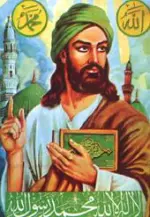

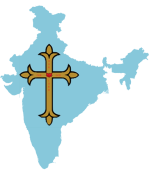


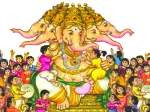



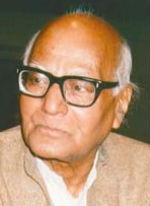






Namaste 🙏🏻
Thanks for this eye opening article based on thorough research and historical facts.
I’d never had given this a serious thought if my personal search for truth hadn’t led me to questioning and unlearning most of the Catholic dogma and church doctrine (respectively) that I’d been indoctrinated in all my life.
LikeLike
There are many churches in the name of this pirate in Kerala. The adherents are all fushermen who lead a very licentious lives and are shunned by all classes of people except for the Cobgress party of Gandhi Nehru for whom these untouchables are solid vote bank in elections
LikeLike
Francis Xavier was a short Spanish priest and not tall.
LikeLike
Appeal to Heads of India and Sri Lanka to initiate an impartial DNA test : Ven. Thotagamuwe Sri Rahula or Francis Xavier – Shenali Waduge – LankaWeb – December 9th, 2014
Sri Lanka must demand the return of the remains of Ven. Thotagamuwe Sri Rahula from Goa, if the DNA tests prove positive – Shenali D. Waduge – LankaWeb – November 27th, 2014
LikeLike
“Goa is sadly famous for its Inquisition, equally contrary to humanity and commerce. The Portuguese monks made us believe that the people worshipped the devil, and it is they who have served him.” – Voltaire
Xavier’s resting place replaces Shiva temple
The Church of Bom Jesus displaced a Saptakotishwar Shiva Temple in Old Goa. This was a second temple as the main deity was at Narve.
Saptakotishwar was the deity of the Kadamba dynasty around the twelfth century. The main temple was at Narve. It was destroyed by the Bahamani Sultan Allauddin Hasan Gangu in 1352, and rebuilt in 1367 by Vijayanagar King Harihararaya.
Because the church replaces a Shiva temple, there is a tradition in Goa that the Basilica of Bom Jesus — a basilica is a church that has special privileges, i.e. the bishop has a private altar to say Mass and doesn’t have to share altars with the parish priest — cannot keep a cross on the roof of the church. It keeps falling down for one reason or another.
Xavier’s body was switched for that of a Buddhist monk – Capt Ajit Vadakayil
On 11th Dec 1553, Xavier’s dead body was shipped from China to Goa.
The Pope’s propaganda has caught on that viewing his dead embalmed body can bring miraculous good fortune and can heal you of all your ailments. Why not? He has converted more people to Christianity than any of Jesus’s disciples. The “Vatican poster boy’s” embalmed body lies in Goa and is exposed to the public every 10 years—the last was in Dec 2002. Two million of the faithful has descended on Goa for a month. The Vatican has been ignoring demands from the descendants of a Buddhist monk for a DNA test — who claim that the body is of a Sri Lankan monk. The body was switched after the arrogant Captain of the Portugese ship threw it overboard. The monk had died due to consumption of a rare herb. The preserved body of the monk was snatched by Portugese soldiers, dressed up in catholic priest garb and brought to Goa. There is a witness to this — Francis Xavier’s own converted servant he took from my hometown Calicut, by the name of Christopher.
Xavier was a tall white man– the body is of a small dark man. The bullshit given is that his body was put in lime, in China — so the great appearance change. DNA test never lies!!
And lime does NOT convert white skin to a uniform brown texture!
Dr. Teotonio R. de Souza
“Xavier was aware of the brutality of the Inquisition,” says Dr. De Souza – Devika Sequeira – Deccan Herald – Bangalore – 4 Dec. 2012
One of the darkest chapters in Indo-Portuguese history, ‘the Inquisition’ deserves far more comprehensive research to bring out the truth from an Indian perspective, says historian Teotonio R de Souza.
Head of the Department of History, Universidade Lusofona de Humanidades e Tecnologias, the Lisbon-based De Souza who has published 10 books. He spoke to Devika Sequeira of Deccan Herald. Excerpts:
This year marks 500 years of the Portuguese arrival in Goa in 1510 which set the stage for one of the longest colonial dominations in history. Academically, how significant is this anniversary?
— While the Portuguese had already started their commercial links at Cannanore-Calicut-Cochin about a decade earlier, the conquest of Goa marked a turning-point in their policy, namely the decision to secure a land-base of their own with full sovereignty. Two decades later it was made the headquarters of the new empire, which from 1505 was named Estado da India. As Afonso de Albuquerque wrote to his king, the settling down in Goa of casados (married settlers) would send a signal to all in India that the Portuguese had come to stay!
Given the complex and often bitter political relationship between Goa and Portugal post the 1961 Liberation, Goa has given the event a complete miss. How should it have responded in your view?
— It was unfortunate that the Salazar regime (Portuguese dictator Antonio de Oliveira Salazar) was not flexible enough to compromise and dialogue with newly independent India. It was a regime that was also blind to world developments and survived till 1974 causing much heartache to the Portuguese themselves. Goans cannot though deny the fact that Goa owes its unique identity, and consequently its statehood, to the colonial experience — albeit that identity might have come from both good and bad experiences. The Portuguese republic in 1910 reduced the earlier restraints upon the Hindu population and extended to them the political benefits of liberalism. Goa could join Portugal this year in commemorating 100 years of this event. Goans should know that Portugal too has grown through harsh experiences of their own people. It would benefit Goans and the Portuguese to share these mutual experiences.
Can you throw some light on the Goa Inquisition?
— The Goa Inquisition has been studied, but most studies concentrate upon the victims of Jewish descent. They were the main targets of the tribunals of Inquisition everywhere. However, the number of native victims, though less harshly treated, was proportionately much larger. Even the lighter sentences were traumatic for the natives and disrupted their family and social lives. Many spent years in forced labour in galleys and gunpowder factories, which needed cheap labour for the needs of the empire. But the fear and panic caused by the Inquisition procedures drove many out of the territory. A lot more incisive research would be required to trace these cases.
Those accused of religious heresies and who refused to retract, or those accused of relapses in sodomy were the prime targets of death penalty. Many others were imprisoned and released with lighter sentences.
The Inquisition was established in Goa in 1560 at the behest of St Francis Xavier. Was he aware of the brutality of the Inquisition tribunal?
— Francis Xavier and Simão Rodrigues, two founder-members of the Society of Jesus were together in Lisbon before Francis Xavier left for India. Both were asked to assist spiritually the prisoners of the Inquisition and were present at the very first auto-da-fé [burning at the stake] celebrated in Portugal in September 1540, at which 23 were absolved and two were condemned to be burnt, including a French cleric. Hence, Francis Xavier could not have been unaware of the brutality of the Inquisition.
There was a debate a few years ago about excavating the well of the Inquisition that lies buried under the lawns of the See Cathedral in Old Goa. The issue was never pursued for fear of hurting religious sentiments. Is historical truth not obscured by such an attitude?
— All research related to the Inquisition that played havoc in the lives of Goans needs to be welcomed. The fears are generally unfounded. The Inquisition was not a religious institution, but essentially a political institution for disciplining all colonial subjects. I have more than once proposed the creation of an Inquisition Museum that could be a wonderful instrument of education and would even add to the income of cultural tourism. I think only a prolonged debate over this issue could clear the minds from unwarranted fears and sectarian prejudices.
Across Goa priceless stone carvings and ruins of pre-Portuguese temples lie unprotected and abandoned. What should be done about these?
— The situation is much better today. Gritly von Miiterwalner, a German archeologist/anthropologist collected dozens of rare old stones — satikal and viragal — all over Goa, and handed them over to the Archaeological Survey of India in the mid 60s. This effort has to continue and perhaps local panchayats could be involved in protecting and displaying their cultural heritage. That could help carry cultural tourism to the hinterland.
The Goa Inquisition – Dr. T. R. de Souza
At least from 1540 onwards, and in the island of Goa before that year, all the Hindu idols had been annihilated or had disappeared, all the temples had been destroyed and their sites and building material was in most cases utilized to erect new Christian Churches and chapels. Various viceregal and Church council decrees banished the Hindu priests from the Portuguese territories; the public practices of Hindu rites including marriage rites, were banned; the state took upon itself the task of bringing up Hindu orphan children; the Hindus were denied certain employments, while the Christians were preferred; it was ensured that the Hindus would not harass those who became Christians, and on the contrary, the Hindus were obliged to assemble periodically in Churches to listen to preaching or to the refutation of their religion.
A particularly grave abuse was practiced in Goa in the form of ‘mass baptism’ and what went before it. The practice was begun by the Jesuits and was alter initiated by the Franciscans also. The Jesuits staged an annual mass baptism on the Feast of the Conversion of St. Paul (January 25), and in order to secure as many neophytes as possible, a few days before the ceremony the Jesuits would go through the streets of the Hindu quarter in pairs, accompanied by their Negro slaves, whom they would urge to seize the Hindus. When the blacks caught up a fugitive, they would smear his lips with a piece of beef, making him an ‘untouchable’ among his people. Conversion to Christianity was then his only option.
The Goan inquisition is regarded by all contemporary portrayals as the most violent inquisition ever executed by the Portuguese Catholic Church. It lasted from 1560 to 1812. The inquisition was set as a tribunal, headed by a judge, sent to Goa from Portugal and was assisted by two judicial henchmen. The judge was answerable to no one except to Lisbon and handed down punishments as he saw fit. The Inquisition Laws filled 230 pages and the palace where the Inquisition was conducted was known as the Big House and the Inquisition proceedings were always conducted behind closed shutters and closed doors. The screams of agony of the victims (men, women, and children) could be heard in the streets, in the stillness of the night, as they were brutally interrogated, flogged, and slowly dismembered in front of their relatives. Eyelids were sliced off and extremities were amputated carefully, a person could remain conscious even though the only thing that remained was his torso and head.
Diago de Boarda, a priest and his advisor Vicar General, Miguel Vazz had made a 41 point plan for torturing Hindus. Under this plan Viceroy Antano de Noronha issued in 1566, an order applicable to the entire area under Portuguese rule:
“I hereby order that in any area owned by my master, the king, nobody should construct a Hindu temple and such temples already constructed should not be repaired without my permission. If this order is transgressed, such temples shall be, destroyed and the goods in them shall be used to meet expenses of holy deeds, as punishment of such transgression.”
In 1567 the campaign of destroying temples in Bardez met with success. At the end of it 300 Hindu temples were destroyed. Enacting laws, prohibition was laid from December 4, 1567 on rituals of Hindu marriages, sacred thread wearing and cremation. All the persons above 15 years of age were compelled to listen to Christian preaching, failing which they were punished.
A religious fatwa was issued on the basis of the findings of Goa Inquiry Commission. It stated, “… Hereby we declare the decision that the conventions mentioned in the preamble of the fatwa as stated below are permanently declared as useless, and therefore prohibited.”
Prohibitions regarding marriages:
— The instruments for Hindu songs shall not be played.
— While giving dowry the relatives of the bride and groom must not be invited.
— At the time of marriage, betel leaf packages (pan) must not be distributed either publicly or in private to the persons present.
— Flowers, or fried puris, betel nuts and leaves must not be sent to the heads of the houses of the bride or groom.
— Gotraj ceremony of family God must not be performed.
— On the day prior to a wedding, rice must not be husked, spices must not be pounded, grains must not be ground and other recipes for marriage feast must not be cooked.
— Pandals and festoons must not be used.
— Pithi should not be applied.
— The bride must not be accorded ceremonial welcome. The bride and groom must not be made to sit under pandal to convey blessings and best wishes to them.
— The poor must not be fed or ceremonial meals must not be served for the peace of the souls of the dead.
— There should be no fasting on ekadashi day.
— Fasting can be done according to the Christian principles.
— No rituals should be performed on the twelfth day after death, on moonless and full moon dates.
— Hindu men should not wear dhoti either in public or in their houses.
— Women should not wear cholis.
— They should not plant Tulsi in their houses, compounds, gardens or any other place.
Following the law of 1567, orphans were kidnapped for converting them to Christianity.
On September 22, 1570 an order was issued that:
— The Hindus embracing Christianity will be exempted from land taxes for a period of 15 years.
— Nobody shall bear Hindu names or surnames.
In 1583 Hindu temples at Esolna and Kankolim were destroyed through army action.
“The fathers of the Church forbade the Hindus under terrible penalties the use of their own sacred books, and prevented them from all exercise of their religion. They destroyed their temples, and so harassed and interfered with the people that they abandoned the city in large numbers, refusing to remain any longer in a place where they had no liberty, and were liable to imprisonment, torture and death if they worshipped after their own fashion the gods of their fathers.” wrote Sasetti, who was in India from 1578 to 1588.
An order was issued in June 1684 eliminating Konkani language and making it compulsory to speak Portuguese language. The law provided for dealing toughly with anyone using the local language. Following that law all the symbols of non-Christian sects were destroyed and the books written in local languages were burnt.
The Archbishop living on the banks of the Ethora had said during one of his lecture series, “The post of Inquiry Commission in Goa is regarded as holy.” The women who opposed the assistants of the commission were put behind the bars and were used by them to satisfy their animal instincts. Then they were burnt alive as opponents of the established tenets of the Catholic Church.
The victims of such inhuman laws of the Inquiry Commission included a French traveller named Delone. He was an eye witness to the atrocities, cruelty and reign of terror unleashed by priests. He published a book in 1687 describing the lot of helpless victims. While he was in jail he had heard the cries of tortured people beaten with instruments having sharp teeth. All these details are noted in Delone’s book.
So harsh and notorious was the Inquisition in Goa, that word of its brutality and horrors reached Lisbon but nothing was done to stop this notoriety and escalating barbarity and it continued for two hundred more years. Nobody knows the exact number of Goans subjected to these diabolical tortures, but perhaps it runs into hundreds of thousands, may be even more. The abominations of inquisitions continued until a brief respite was given in 1774 but four years later, the inquisition was introduced again and it continued un-interruptedly until 1812. At that point in time, in the year of 1812, the British put pressure on the Portuguese to put an end to the terror of Inquisition and the presence of British troops in Goa enforced the British desire. Also the Portuguese power at this time was declining and they could not fight the British. The palace of the Grand Inquisitor, the Big House, was demolished and no trace of it remains today, which might remind someone of inquisitions and the horrors inside this Big House that their great saint Francis Xavier had commenced.
Dr. Trasta Breganka Kunha, a Catholic citizen of Goa writes, “Inspite of all the mutilations and concealment of history, it remains an undoubted fact that religious conversion of Goans is due to methods of force adopted by the Portuguese to establish their rule. As a result of this violence the character of our people was destroyed. The propagation of Christian sect in Goa came about not by religious preaching but through the methods of violence and pressure. If any evidence is needed for this fact, we can obtain it through law books, orders and reports of the local rulers of that time and also from the most dependable documents of the Christian sect.”
Thus Spoke Francis Xavier
In his letters to the Jesuits in Rome, Xavier wrote: “There are in these parts among the pagans a class of men called Brahmins. They are as perverse and wicked a set as can anywhere be found, and to whom applies the Psalm which says: ‘From an unholy race, and wicked and crafty men, deliver me, Lord.’ If it were not for the Brahmins, we should have all the heathens embracing our faith.”
“Following the baptisms, the new Christians return to their homes and come back with their wives and families to be in their turn also prepared for baptism. After all have been baptised, I order that everywhere the temples of the false gods be pulled down and idols broken. I know not how to describe in words the joy I feel before the spectacle of pulling down and destroying the idols by the very people who formerly worshipped them.” Xavier did this after the Hindu Raja of Quilon had given him a large grant to build churches!
On baptising and inducting children into Christianity, he wrote in 1543 to the Society of Jesus in Rome: “These children, I trust heartily, by the grace of God, will be much better than their fathers. They show an ardent love for the Divine law, and an extraordinary zeal for learning our holy religion and imparting it to others. Their hatred for idolatry is marvellous. They get into feuds with the heathen about it, and whenever their own parents practise it, they reproach them and come off to tell me at once. Whenever I hear of any act of idolatrous worship, I go to the place with a large band of these children, who very soon load the devil with a greater amount of insult and abuse than he has lately received of honor and worship from their parents, relations, and acquaintances. The children run at the idols, upset them, dash them down, break them to pieces, spit on them, trample on them, kick them about, and in short heap on them every possible outrage.”
Xavier’s letter demanding the Inquisition be sent to Goa
Francis Xavier sent this letter to King John III of Portugal on May 16th, 1545: “The second necessity for the Christians is that your Majesty establish the Holy Inquisition, because there are many who live according to the Jewish law, and according to the Mahomedan sect, without any fear of God or shame of the world. And since there are many spread all over the fortresses, there is the need of the Holy Inquisition and of many preachers. Your Majesty should provide such necessary things for your loyal and faithful subjects in India.” – Joseph Wicki, Documenta Indica, Vol. IV, Rome, 1956.
The Inquisition in Goa
Historian Paul Roberts describes what went on in the Inquisition’s Goa court that had been housed in the Sultan’s old palace and had a huge plaster image of Christ overlooking the scene: “Children were flogged and slowly dismembered in front of their parents, whose eyelids had been sliced off to make sure they missed nothing. Extremities were amputated carefully, so that a person could remain conscious even when all that remained was a torso and head. Male genitals were removed and burned in front of wives, breasts hacked off and vaginas penetrated by swords while husbands were forced to watch…. And it went on for two hundred years.” – Paul Williams Roberts, The Empire of the Soul: Some Journeys in India, New York, 1997.
Anti-Brahminism
Francis Xavier was the pioneer of anti-Brahmanism which was adopted in due course as a major plank in the missionary propaganda by all Christian denominations. Lord Minto, Governor General of India from 1807 to 1812, submitted a Note to his superiors in London when the British Parliament was debating whether missionaries should be permitted in East India Company’s domain under the Charter of 1813. He enclosed with his Note some “propaganda material used by the missionaries” and, referring to one missionary tract in particular, wrote: “The remainder of this tract seems to aim principally at a general massacre of the Brahmanas.” (M. D. David (ed.), Western Colonialism in Asia and Christianity, Bombay, 1988, p. 85). Anti-Brahmanism has become the dominant theme in the speeches and writings of Dravidian politicians and Indian secularists of all sorts.
How I Came to Write “Guardian of the Dawn” – Richard Zimler
Extract from the middle of the article:
Readers might be interested in Xavier’s innovations in day care, that so captured the imagination of the doctores of the Mother Church who so fondly and gently ‘suffers the little ones to come unto her,’ that he was canonized:
Perhaps I didn’t read carefully enough, but Shri Goel seems to have missed this rather instructive, nay revelatory, piece in his book “Francis Xavier SJ.” It gives an entirely new twist to what is arguably the rage in our nursery schools: “Learning by doing.” – KS
LikeLike
Readers might be interested in Xavier’s innovations in day care, that so captured the imagination of the doctores of the Mother Church who so fondly and gently ‘suffers the little ones to come unto her,’ that he was canonized:
http://www.fordham.edu/halsall/mod/1543xavier1.asp
Perhaps I didn’t read carefully enough, but Shri Goel seems to have missed/omitted this rather instructive, nay revelatory, piece in his book “Francis Xavier SJ.” It gives an entirely new twist to what is arguably the rage in our nursery schools: “Learning by doing.”
LikeLike
What has been rectified? Both Muslims and Christians continue their hate campaign against Hindus till today.
LikeLike
History is a good teacher and so is time, except time does kill her students. Learn from history and undo the wrongs done in the past for that is all one can do. The present is always constant and it is in the present the wrongs of the past be rectified. A classic example is the Somnath Temple in Gujarat built for the sun God Surya. The Muslims destroyed it and the Hindus rebuilt it. This took place seven times. The last destruction of that temple has been rectified by a new Temple that now stands proudly on that site.
LikeLike
Have you read this book?
Orissa in the Crossfire: Kandhamal Burning
http://www.scribd.com/doc/34732553/ORISSA-in-the-CROSSFIRE-Kandhamal-Burning
LikeLike
Anonymous. The story you have presented of a Jewish boy being kidnapped and converted is unknown to Indians. It is very good web site, since it has many other true incidents of the Vatican. One thing which is good about the web site presented is of s Prof from a A grade University in USA.
LikeLike
Divadi Island is adjacent to Old Goa in the Mandovi River. This island temple appears to be different than the one displaced by Bom Jesus Basilica. But as different temples can have the same name, the temple displaced by the church may have been called Saptakotiswar too.
LikeLike
http://shrisaptakotishwar.com/index.php/history/4-devasthan
This must be the web site.
LikeLike
The Church of Bom Jesus displaced a Saptakotishwar Shiva Temple in Old Goa. This was a second temple as the main deity was at Narve.
Saptakotishwar was the deity of the Kadamba dynasty around the twelfth century. The main temple was at Narve. It was destroyed by the Bahamani Sultan Allauddin Hasan Gangu in 1352, and rebuilt in 1367 by Vijayanagar King Harihararaya.
Because the church replaces a Shiva temple, there is a tradition in Goa that the Basilica of Bom Jesus — a basilica is a church that has some special privileges, i.e. the bishop has a private altar to say Mass and doesn’t have to share altars with the parish priest — cannot keep a cross on the roof of the church. It keeps falling down for one reason or another.
LikeLike
The Goa Inquisition by A.K. Priolkar is reprinted and available from Voice of India, New Delhi. Go to the Aditya Prakashan website to order it (PB edition Rs 300.00).
LikeLike
This book is difficult to get, but praised by scholars.
http://en.wikipedia.org/wiki/The_Goa_Inquisition_(book)
Priolkar, A.K 1961, “The Goa Inquisition, Being a Quatercentenary Commemoration Study of the Inquisition in India”, Bombay University.
Peer reviews
The book was very well-reviewed by his peers. Gerald M. Moser of Penn State University said that the book was an authoritative work on the event based on accounts of European travellers and Portuguese historians.[1] The book was written one year prior to the liberation of Goa from Portuguese occupation by India, so it “reopened old wounds, recalling the dismal record of European religious intolerance” in India “through the most pitiless inquisition of Christendom”.[1] Priolkar did not exaggerate the intolerant zeal of the Christian Missionaries, nor did he try to understand it.[1]
LikeLike
Yes, this book is an important historical resource.
All the records of the Goa Inquisition were lost or destroyed after India occupied the state in 1961. This was done by Portuguese officials because they feared the tens of thousands of law suits that would have been brought against Portugal and the Church regarding confiscated property that the Inquisition took from Hindus and Christian apostates.
LikeLike
LikeLike
http://archive.org/details/accountofinquisi00dell
An Account of the Inquisition at Goa, in India (1819)
See to the left side, the english translation you can download. It may be interesting.
LikeLike
http://ajitvadakayil.blogspot.com.au/2010/12/portuguese-inquisition-in-goa-and.html
On 11th Dec 1553 , Xavier’s dead body was shipped from China to Goa.
The Pope’s propaganda has caught on that viewing his dead embalmed body can bring miraculous good fortune and can heal you of all your ailments. Why not? He has converted more people to Christianity than any of Jesus’s disciples.The “Vatican Poster boy’s” embalmed body lies in Goa and is exposed to the public every 10 years—the last was in Dec 2002. Two million of the faithful has descended on Goa for a month. The Vatican has been ignoring demands from the descendants of a Buddhist monk for a DNA test — who claim that the body is of a Sri Lankan monk. The body was switched after the arrogant Captain of the Portugese ship threw it overboard. The monk had died due to consumption of a rare herb. The preserved body of the monk was snatched by Portugese soldiers, dressed up in catholic priest garb and brought to Goa. There is a witness to this — Francis Xavier’s own converted servant he took from my hometown Calicut, by the name of Christopher.
Xavier was a tall white man– the body is of a small dark man. The bullshit given is that his body was put in lime, in China — so the great appearance change. DNA test never lies!!
And lime does NOT convert white skin to a uniform brown texture!!!
LikeLike
Thank you but no. The deity had a proper name starting K and ending -ishwar or -eshwar.
I will look for it as it is an important historical fact. Xians are very good at covering up their temple breaking, so they have to be exposed. It is just that I have no time to go through 2000 comments!
LikeLike
The Goa Inquisition – Dr. T. R. De Souza
“At least from 1540 onwards, and in the island of Goa before that year, all the Hindu idols had been annihilated or had disappeared, all the temples had been destroyed and their sites and building material was in most cases utilized to erect new Christian Churches and chapels. Various viceregal and Church council decrees banished the Hindu priests from the Portuguese territories; the public practices of Hindu rites including marriage rites, were banned; the state took upon itself the task of bringing up Hindu orphan children; the Hindus were denied certain employments, while the Christians were preferred; it was ensured that the Hindus would not harass those who became Christians, and on the contrary, the Hindus were obliged to assemble periodically in Churches to listen to prea! ching or to the refutation of their religion.”
“A particularly grave abuse was practiced in Goa in the form of ‘mass baptism’ and what went before it. The practice was begun by the Jesuits and was alter initiated by the Franciscans also. The Jesuits staged an annual mass baptism on the Feast of the Conversion of St. Paul (January 25), and in order to secure as many neophytes as possible, a few days before the ceremony the Jesuits would go through the streets of the Hindu quarter in pairs, accompanied by their Negro slaves, whom they would urge to seize the Hindus. When the blacks caught up a fugitive, they would smear his lips with a piece of beef, making him an ‘untouchable’ among his people. Conversion to Christianity was then his only option.”
The Goan inquisition is regarded by all contemporary portrayals as the most violent inquisition ever executed by the Portuguese Catholic Church. It lasted from 1560 to 1812. The inquisition was set as a tribunal, headed by a judge, sent to Goa from Portugal and was assisted by two judicial henchmen. The judge was answerable to no one except to Lisbon and handed down punishments as he saw fit. The Inquisition Laws filled 230 pages and the palace where the Inquisition was conducted was known as the Big House and the Inquisition proceedings were always conducted behind closed shutters and closed doors. The screams of agony of the victims (men, women, and children) could be heard in the streets, in the stillness of the night, as they were brutally interrogated, flogged, and slowly dismembered in front of their relatives. Eyelids were sliced off and extremities were amputated carefully, a person could remain conscious even though the only thing that remained was his torso and head.
Diago de Boarda, a priest and his advisor Vicar General, Miguel Vazz had made a 41 point plan for torturing Hindus. Under this plan Viceroy Antano de Noronha issued in 1566, an order applicable to the entire area und! er Portuguese rule:
“I hereby order that in any area owned by my master, the king, nobody should construct a Hindu temple and such temples already constructed should not be repaired without my permission. If this order is transgressed, such temples shall be, destroyed and the goods in them shall be used to meet expenses of holy deeds, as punishment of such transgression.”
In 1567 the campaign of destroying temples in Bardez met with success. At the end of it 300 Hindu temples were destroyed. Enacting laws, prohibition was laid from December 4, 1567 on rituals of Hindu marriages, sacred thread wearing and cremation. All the persons above 15 years of age were compelled to listen to Christian preaching, failing which they were punished.
A religious fatwa was issued on the basis of the findings of Goa Inquiry Commission. It stated, “…Hereby we declare the decision that the conventions mentioned in the preamble of the fatwa as stated below are permanently declared as useless, and therefore prohibited.”
Prohibitions regarding marriages:
Following the law of 1567, orphans were kidnapped for converting them to Christianity.
On September 22, 1570 an order was issued that:
In 1583 Hindu temples at Esolna and Kankolim were destroyed through army action.
“The fathers of the Church forbade the Hindus under terrible penalties the use of their own sacred books, and prevented them from all exercise of their religion. They destroyed their temples, and so harassed and interfered with the people that they abandoned the city in large numbers, refusing to remain any longer in a place where they had no liberty, and were liable to imprisonment, torture and death if they worshipped after their own fashion the gods of their fathers.” wrote Sasetti, who was in India from 1578 to 1588.
An order was issued in June 1684 eliminating Konkani language and making it compulsory to speak Portuguese language. The law provided for dealing toughly with anyone using the local language. Following that law all the symbols of non-Christian sects were destroyed and the books written in local languages were burnt.
The Archbishop living on the banks of the Ethora had said during one of his lecture series, “The post of Inquiry Commission in Goa is regarded as holy.” The women who opposed the assistants of the commission were put behind the bars and were used by them to satisfy their animal instincts. Then they were burnt alive as opponents of the established tenets of the Catholic Church.
The victims of such inhuman laws of the Inquiry Commission included a French traveller named Delone. He was an eye witness to the atrocities, cruelty and reign of terror unleashed by priests. He published a book in 1687 describing the lot of helpless victims. While he was in jail he had heard the cries of tortured people beaten with instruments having sharp teeth. All these details are noted in Delone’s book.
So harsh and notorious was the Inquisition in Goa, that word of its brutality and horrors reached Lisbon but nothing was done to stop this notoriety and escalating barbarity and it continued for two hundred more years. Nobody knows the exact number of Goans subjected to these diabolical tortures, but perhaps it runs into hundreds of thousands, may be even more. The abominations of inquisitions continued until a brief respite was given in 1774 but four years later, the inquisition was introduced again and it continued un-interruptedly until 1812. At that point in time, in the year of 1812, the British put pressure on the Portuguese to put an end to the terror of Inquisition and the presence of British troops in Goa enforced the British desire. Also the Portuguese power at this time was declining and they could not fight the British. The palace of the Grand Inquisitor, the Big House, was demolished and no trace of it remains today, which might remind someone of inquisitions and the horrors inside this Big House that their great saint Francis Xavier had commenced.
Dr. Trasta Breganka Kunha, a Catholic citizen of Goa writes, “Inspite of all the mutilations and concealment of history, it remains an undoubted fact that religious conversion of Goans is due to methods of force adopted by the Portuguese to establish their rule. As a result of this violence the character of our people was destroyed. The propagation of Christian sect in Goa came about not by religious preaching but through the methods of violence and pressure. If any evidence is needed for this fact, we can obtain it through law books, orders and reports of the local rulers of that time and also from the most dependable documents of the Christian sect.”
LikeLike
http://www.vgweb.org/unethicalconversion/GoaInquisition.htm
by T.R. De Souza
http://www.vgweb.org/unethicalconversion/
All articles here are good.
LikeLike
You write: “Most European Jesuits are deeply ashamed of Xavier’s missionary methods and his advocacy of forced conversion, and try to ignore him.”
In my opinion, that’s the difference between first and third world Christianity. In the third world, the more muscular and full-blooded variety of Christianity prevails, but this widespread distemper is not known (or deliberately downplayed) among even well-intentioned secularists in the western world. Worse, western governments cynically provide tacit and material support to maniacal third world Christian ‘liberation’ movements and ‘NGOs’ that they wouldn’t tolerate for a moment in their backyard.
As Elst once wrote:
http://www.rediff.com/news/2002/sep/03guest.htm
“…The Indian people are not financing movements violently disrupting American society. By contrast, American citizens are financing Church activities in India which often shade over into armed separatism, social disruption of tribal societies and ethnic cleansing. The American state is arming Pakistan, and even if it were to fully stop arms deliveries to Pakistan, it still carries a legacy of having armed the Pakistani Army and trained the Pakistani secret service, agents of terror against Indian citizens and the Indian state. The guilt for keeping Indo-American relations unfriendly is entirely on the American side. If Dr Hathaway believes in a “new partnership between our two peoples”, he had better advise his Government to investigate American private support to missionary-cum-terrorist subversion and to halt every form of American state support to Pakistani jihadism.”
LikeLike
Thank you very much for the link. Dr. Teotonio R. de Souza is the very best authority on the Portuguese in Goa. He should be listened to carefully.
Of course Xavier was aware of the brutality of the Inquisition. That is why he demanded their presence in Goa. He was an advocate of forced conversion. The Inquisition was the best Church institution to apply force in a conversion!
Dr. Teotonio R. de Souza
Here is the full article:
‘Xavier was aware of the brutality of the Inquisition,’ says Dr. De Souza – Devika Sequeira – Deccan Herald – Bangalore – 4 Dec. 2012
One of the darkest chapters in Indo-Portuguese history, ‘the Inquisition’ deserves far more comprehensive research to bring out the truth from an Indian perspective, says historian Teotonio R de Souza.
Head of the department of history, Universidade Lusofona de Humanidades e Tecnologias, the Lisbon-based De Souza who has published 10 books spoke to Devika Sequeira of Deccan Herald. Excerpts:
This year marks 500 years of the Portuguese arrival in Goa in 1510 which set the stage for one of the longest colonial dominations in history. Academically, how significant is this anniversary?
While the Portuguese had already started their commercial links at Cannanore-Calicut-Cochin about a decade earlier, the conquest of Goa marked a turning-point in their policy, namely the decision to secure a land-base of their own with full sovereignty. Two decades later it was made the headquarters of the new empire, which from 1505 was named Estado da India. As Afonso de Albuquerque wrote to his king, the settling down in Goa of casados (married settlers) would send a signal to all in India that the Portuguese had come to stay!
Given the complex and often bitter political relationship between Goa and Portugal post the 1961 Liberation, Goa has given the event a complete miss. How should it have responded in your view?
It was unfortunate that the Salazar regime (Portuguese dictator Antonio de Oliveira Salazar) was not flexible enough to compromise and dialogue with newly independent India. It was a regime that was also blind to world developments and survived till 1974 causing much heartache to the Portuguese themselves. Goans cannot though deny the fact that Goa owes its unique identity, and consequently its statehood, to the colonial experience —- albeit that identity might have come from both good and bad experiences. The Portuguese republic in 1910 reduced the earlier restraints upon the Hindu population and extended to them the political benefits of liberalism. Goa could join Portugal this year in commemorating 100 years of this event. Goans should know that Portugal too has grown through harsh experiences of their own people. It would benefit Goans and the Portuguese to share these mutual experiences.
Can you throw some light on the Goa Inquisition?
The Goa Inquisition has been studied, but most studies concentrate upon the victims of Jewish descent. They were the main targets of the tribunals of Inquisition everywhere. However, the number of native victims, though less harshly treated, was proportionately much larger. Even the lighter sentences were traumatic for the natives and disrupted their family and social lives. Many spent years in forced labour in galleys and gunpowder factories, which needed cheap labour for the needs of the empire. But the fear and panic caused by the Inquisition procedures drove many out of the territory. A lot more incisive research would be required to trace these cases.
Those accused of religious heresies and who refused to retract, or those accused of relapses in sodomy were the prime targets of death penalty. Many others were imprisoned and released with lighter sentences.
The Inquisition was established in Goa in 1560 at the behest of St Francis Xavier. Was he aware of the brutality of the Inquisition tribunal?
Francis Xavier and Simão Rodrigues, two founder-members of the Society of Jesus were together in Lisbon before Francis Xavier left for India. Both were asked to assist spiritually the prisoners of the Inquisition and were present at the very first auto-da-fé celebrated in Portugal in September 1540, at which 23 were absolved and two were condemned to be burnt, including a French cleric. Hence, Francis Xavier could not have been unaware of the brutality of the Inquisition.
There was a debate a few years ago about excavating the well of the Inquisition that lies buried under the lawns of the See Cathedral in Old Goa. The issue was never pursued for fear of hurting religious sentiments. Is historical truth not obscured by such an attitude?
All research related to the Inquisition that played havoc in the lives of Goans needs to be welcomed. The fears are generally unfounded. The Inquisition was not a religious institution, but essentially a political institution for disciplining all colonial subjects. I have more than once proposed the creation of an Inquisition Museum that could be a wonderful instrument of education and would even add to the income of cultural tourism. I think only a prolonged debate over this issue could clear the minds from unwarranted fears and sectarian prejudices.
Across Goa priceless stone carvings and ruins of pre-Portuguese temples lie unprotected and abandoned. What should be done about these?
The situation is much better today. Gritly von Miiterwalner, a German archeologist/anthropologist collected dozens of rare old stones — satikal and viragal — all over Goa, and handed them over to the Archaeological Survey of India in the mid 60s. This effort has to continue and perhaps local panchayats could be involved in protecting and displaying their cultural heritage. That could help carry cultural tourism to the hinterland.
LikeLike
http://www.deccanherald.com/content/66330/xavier-aware-brutality-inquisition.html
‘Xavier was aware of the brutality of the Inquisition’
One of the darkest chapters in Indo-Portuguese history, ‘the Inquisition’ deserves far more comprehensive research to bring out the truth from an Indian perspective, says historian Teotonio R de Souza, .department of history, Universidade Lusofona de Humanidades e Tecnologias, the Lisbon-based De Souza who has published 10 books spoke to Devika Sequeira of Deccan Herald.
LikeLike
How Italy became secular state
http://www.davidkertzer.com/books/kidnapping_of_edgardo_mortara.html
The kidnapping of Edgardo Mortara.
LikeLike
Good reference. The Jesuits are trying to disassociate Xavier from the Inquisition on the ground that he died before it was established in Goa. But the fact is that Xavier was an advocate of forced conversion and the Inquistion, which he demanded King John III send to Goa, was the best institution to effect forced conversions as he knew very well.
The Jesuits knew about the horrific methods employed by the Inquisition in Europe and did not allow their members in India to attend the Inquisition’s court in Goa. They felt it would give them a bad reputation! The Inquisition’s court was manned by Augustinian and Franciscan priests and monks who were extraordinarily cruel and perverted men.
It is a curious fact that only Indian Jesuits promote Xavier as a saint and write about him in the mainstream media. Most European Jesuits are deeply ashamed of Xavier’s missionary methods and his advocacy of forced conversion, and try to ignore him.
LikeLike
How I Came to Write “Guardian of the Dawn” – Richard Zimler
http://zimler.com/dDestaque.php?id=16&m=15
Extract from the middle of the above cited article
“Shortly after Portuguese troops conquered Goa from the Sultan of Bijapur in 1510, they began forcing the tens of thousands of Hindu residents to convert to Christianity. In 1540, during a wave of fanaticism, they destroyed 300 Hindu temples, many of them built in ancient times. Then, in 1545, a Spanish Jesuit missionary named Francis Xavier petitioned the Portuguese Crown to establish the Inquisition. Once the king’s approval had been secured, the former Hindu population of Goa, as well as the hundreds of secret Jews living there, found themselves at the complete mercy of the Church. Simply keeping a statue of Shiva in a family shrine, or whispering a Hebrew prayer over the grave of a loved one, became a serious criminal offence. Those discovered to be practicing their old beliefs in secret were summarily arrested and tortured in dungeons, kept in shackles by priests hoping to force them to divulge the names of friends and family members who had joined them in their ‘heretical’ practices.
“Prisoners who refused to identify others or give up their beliefs in Hindu or Jewish ‘sorcery’ were strangled by executioners or burnt alive in public Acts of Faith – from 1560 all the way up to 1812, when the Inquisition was finally abolished”
LikeLike